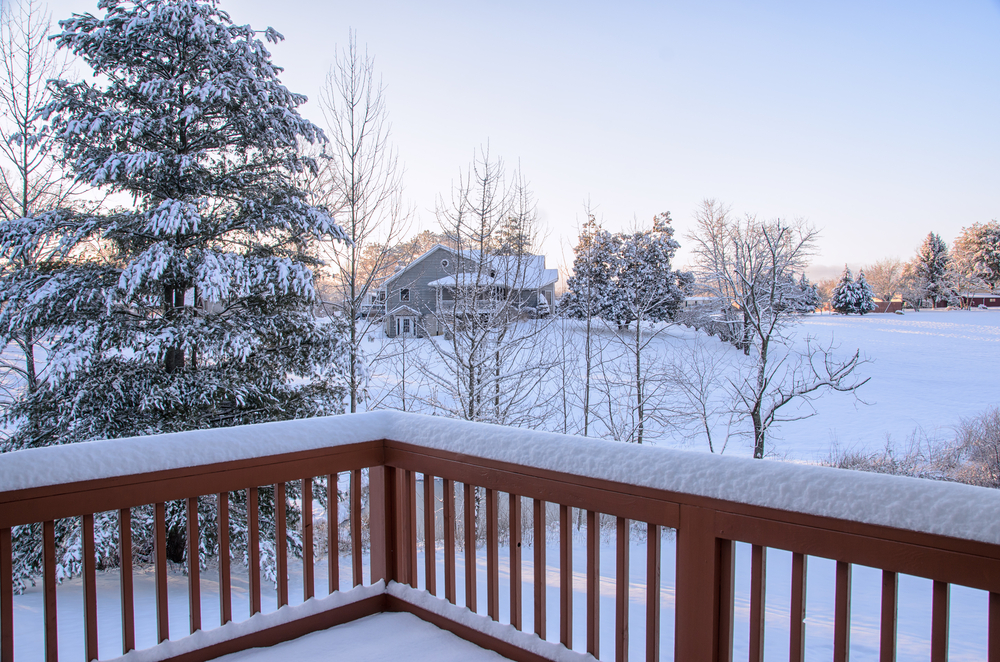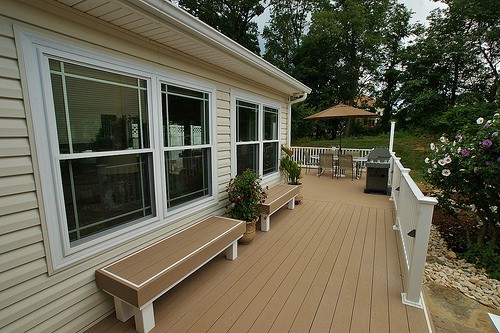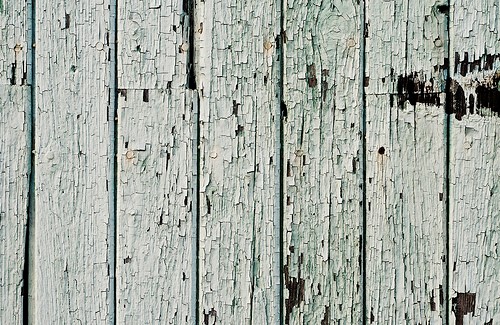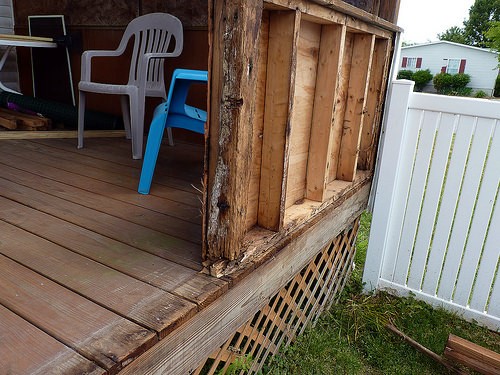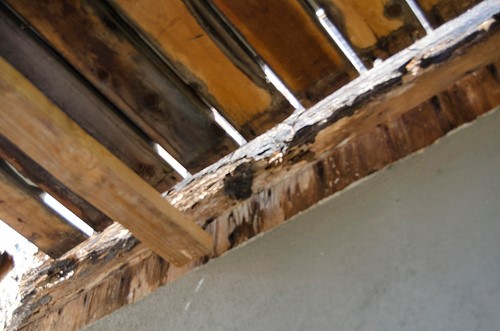7 Ways to Prepare Your Deck for Winter
When you assess deck conditions in preparation for harsh weather this winter, you’ve got to look at the surface of the deck and underneath it to determine if the deck is sturdy enough to handle snow and ice. Let’s take a look at some common problem areas that you need to check for to minimize potential damage caused by the cold months ahead.
1. Repair Localized Board Damage
When inspecting your deck for damage, start with the deck’s surface. Many decks that are otherwise sturdy end up with localized board damage. Factors like water dripping from a tree or an eave onto a single spot, or a plant container leaving a ring of mildew, can cause harm to your decking boards. To determine whether the damage is localized to one spot, or if more than just a few boards are affected, you’ll have to look at the rest of the deck. Are the joists and posts beneath the damage intact?
When the damage is in a small area and has only affected the surface boards of the deck, you can pull up those boards and replace them with new ones. Make sure to assess the space beneath the boards when you pull them up to ensure the damage didn’t spread to an area you couldn’t see. Homeowners who have done deck projects before shouldn’t have a problem turning deck board replacement into a weekend DIY project.
2. Inspect the Whole Deck Surface
Note that damaged boards are not the same as weathered or warped boards. A hardwood deck, even with the right weatherization, will age. Aging wood isn’t something to worry about until it becomes structurally unsound. If your deck boards are slightly warped, you can leave them alone. Once they start to crack, it’s time to take them out and replace them.
When you assess deck quality, take a walk across the deck. Pay attention to how the boards feel beneath your feet. Are they sturdy, or are they spongy, bouncy, or have too much give? These symptoms are not indicative of localized board damage, but of an overarching problem that’s affecting most of your deck surface and probably the structure beneath. Spongy deck boards are almost always a sign it’s time to tear down your deck.
3. Check for Peeling Stain or Paint
If you think your paint may be peeling, stick a strip of tape across the deck and yank it up. If the wood coating isn’t sticking anymore, the tape will pull it up. Peeling paint and stain by itself isn’t a big deal, and it’s something a homeowner can fix. The problem with peeling paint and stain is the potential for water or mold to get to the wood underneath, especially during the wet months of winter and spring. Perform regular deck maintenance to check the quality of your stain to avoid this potential issue.
Before you can lay down a new coat, you’ve got to do re-stain deck preparation, which means sanding or scraping off the old material. Otherwise, that new coat will adhere to all the uneven spots on the wood, and it won’t look smooth or professional. Once you’ve removed the old coat, you can apply another coat of stain or paint. Make sure you buy coating that’s rated for protecting outdoor wood. If your deck is huge, you may want to hire someone to save yourself time.
4. Spot Weak Railings
The railing around your deck shouldn’t have any give to it. If you can wiggle it back and forth, it needs to come down so you can replace it with a new one. When your deck railing is wobbly, the spots where the screws and nails hold it in place have probably gone soft, which allows you to move it back and forth. Putting in additional nails or screws isn’t going to help.
The other reason you want to remove the railing if it’s loose is to look for hidden wood damage. If the place where railing meets deck isn’t holding very well, the wood of the deck may also be damaged. Don’t repair the railing until you’re sure that the damage doesn’t extend further into the deck.
5. Have Broken or Scratched Glass Replaced
Glass installed in deck railings is one of the coolest decking ideas. But replacing glass in your deck railing is a complicated DIY project. You’re dealing with dismantling the parts of the wood that hold the glass in place before replacing a single pane of glass. When the glass in your deck is scratched or damaged, you should call someone to help you unless you’re experienced working with wood and glass.
Clean any dirt and debris off, and visually inspect it for cracks or scratches. Minor scratches will hold through the winter, but cracks are going to get worse and are dangerous to your family and your guests. If you find your deck glass is sustaining consistent damage, glass might not be the best choice for your home, and you should consider wood or metal alternatives.
6. Assess Deck Post Damage
So you’re doing your deck preparation for winter, and you notice that the posts holding your deck up are starting to rot. Unfortunately, deck post damage is extremely difficult to fix, and in most cases you’ll have to take the entire deck down. When the posts are put in, they’re set in cement. Sometimes water can pool around the posts or mud gathers over the years. After a while, this moisture gets into the wood and makes it unstable, seriously compromising the structural integrity of the entire deck.
When you find post damage, it’s time for a serious repair or a deck replacement. Damaged posts can shift or collapse, which means your deck will move or fall on its own. Additional weight on the deck, like a party or a dinner gathering, may be too much for rotting posts and will speed up the process, putting your guests in danger.
To prevent post damage from happening, make sure you clean the area around your posts so that the cement is visible. If you need to, add more cement so it creates a downward gradient, which will leach water and dirt away from the post and back to the ground. If you don’t want to have to think about the wood in your deck rotting ever again, composite decking might be your next choice. Many attractive and sturdy decking designs use composite instead of hardwood, and a huge bonus of composite is how easy it is to maintain. If you’re interested in composite decking, you can take a look at some of the options available here.
7. Examine Joists For Rot
Examining the joists is how you assess deck strength. When they weaken, the entire deck may begin to sag or warp. Joists, unfortunately, tend to suffer rot and mildew more often than other parts of the deck because they aren’t exposed to direct sunlight. When moisture builds up around the screws and nails holding the joists together, the sun doesn’t reach beneath the deck to dry it out. Plus, you’re less likely to notice termite damage unless you frequently walk or crawl beneath your patio, porch, or deck.
Like with post damage, joist problems are a sign that you need to replace your deck. The joists hold up the entire deck surface; you can’t replace them without dismantling the rest of the deck. If you use high-quality decking material in just one part of your deck, the joists are your best bet.
If you aren’t sure whether your deck is safe, ask a professional. If you’ve assessed your deck and are concerned that it might not be ready for the wet months ahead, look into stains and materials that will keep your deck structurally sound throughout the harsh winter weather.
Do you have any questions about evaluating your deck? Let us know in the comments section and we’ll be happy to answer them.

